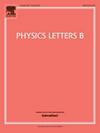用ACT DR6和原始引力波改进了对希格斯-斯塔宾斯基膨胀和再加热的预测
IF 4.5
2区 物理与天体物理
Q1 ASTRONOMY & ASTROPHYSICS
引用次数: 0
摘要
在这封信中,我们利用ACT DR6、普朗克2018、BICEP/Keck 2018和DESI(统称为P-ACT-LB-BK18)的数据,研究了最近CMB观测对希格斯-斯塔宾斯基暴胀模型及其相关再加热动力学的影响。除了直接的CMB限制外,我们还纳入了由原始引力波(PGWs)的潜在过剩产生的间接限制,特别是在大爆炸核合成(BBN)期间相对论性物种有效数量的限制ΔNeff。这些约束在后暴胀状态方程wRH≥0.58的情况下尤为重要。我们的分析表明,当考虑P-ACT-LB-BK18数据和ΔNeff边界时,在2σ置信水平(C.L.)下,暴胀电子折叠的可行数被限制在57.9-62.2范围内。相应的,再加热温度被约束在BBN能量尺度和1012 GeV之间,后暴胀状态方程参数满足wRH>;0.41。然而,一旦包括ΔNeff来自PGWs的约束,在1σ c.l下没有参数空间是可行的,使得希格斯-斯塔宾斯基模型受到高度限制。本文章由计算机程序翻译,如有差异,请以英文原文为准。
Improved predictions on Higgs-Starobinsky inflation and reheating with ACT DR6 and primordial gravitational waves
In this letter, we investigate the implications of recent CMB observations for Higgs-Starobinsky inflationary models and their associated reheating dynamics, utilising data from ACT DR6, Planck 2018, BICEP/Keck 2018, and DESI, collectively referred to as P-ACT-LB-BK18. In addition to direct CMB constraints, we incorporate indirect bounds arising from the potential overproduction of primordial gravitational waves (PGWs), particularly through limits on the effective number of relativistic species, , during Big Bang Nucleosynthesis (BBN). These constraints become especially relevant in scenarios featuring a stiff post-inflationary equation of state . Our analysis shows that, when both P-ACT-LB-BK18 data and bounds are considered, the viable number of inflationary e-folds is restricted to the range 57.9-62.2 at the confidence level (C.L.). Correspondingly, the reheating temperature is constrained to lie between the BBN energy scale and GeV, with the post-inflationary equation-of-state parameter satisfying . However, no parameter space remains viable at the C.L. once constraints from PGWs are included, rendering the Higgs-Starobinsky model highly restricted.
求助全文
通过发布文献求助,成功后即可免费获取论文全文。
去求助
来源期刊

Physics Letters B
物理-物理:综合
CiteScore
9.10
自引率
6.80%
发文量
647
审稿时长
3 months
期刊介绍:
Physics Letters B ensures the rapid publication of important new results in particle physics, nuclear physics and cosmology. Specialized editors are responsible for contributions in experimental nuclear physics, theoretical nuclear physics, experimental high-energy physics, theoretical high-energy physics, and astrophysics.
 求助内容:
求助内容: 应助结果提醒方式:
应助结果提醒方式:


